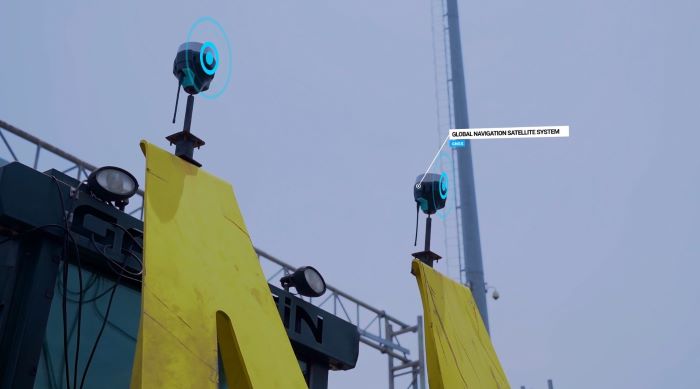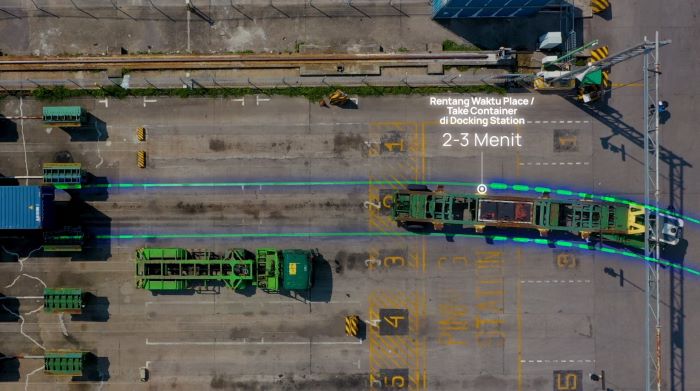AGV CTT, ITB's Automated Vehicle Innovation, Launched at Teluk Lamong Surabaya Container Terminal
By M. Naufal Hafizh, S.S.
Editor M. Naufal Hafizh, S.S.

SURABAYA, itb.ac.id – An innovative technology product created by the children of Indonesia, the Automated Guided Vehicle Combine Terminal Tractor (AGV CTT), was launched at Teluk Lamong Container Terminal, Surabaya, Friday (23/2/2024).
This work is a research collaboration between Institut Teknologi Bandung (ITB), LPDP, PT Pelindo, PT INKA, PT Pelindo Terminal Petikemas, PT Pelindo Terminal Petikemas Teluk Lamong, PT Pelindo Jasa Maritim Bima, and PT Cinovasi.
AGV CTT is an automatic vehicle designed to simplify and speed up the process of loading and unloading containers at container terminals. This vehicle can transport and place containers to and from ships without the need for human assistance.
AGV CTT is a form of ITB's commitment to contribute to the increase of logistics efficiency and productivity in Indonesia, especially in the port sector, considering that ports are gateways for global trade which have their own challenges, such as dense logistics traffic, on-time delivery and increasing operational costs. Therefore, innovative and efficient solutions are needed to solve those problems. AGV CTT automation technology is considered the solution to this issue.

AGV CTT has various advantages, including being able to operate without requiring an operator, saving time and costs on loading and unloading containers, and being able to move containers with a high level of precision since it is equipped with sensitive object detection and good navigation.
In addition to that, the AGV CTT is also equipped with a sophisticated safety system as well as a ground control system so that operations can be monitored and controlled easily from a distance.
The ITB researchers involved in the development of AGV CTT were Prof. Dr.-Ing. Ir. Yul Yunazwin Nazaruddin, M.Sc., DIC., IPM., as chairman, and Augie Widyotriatmo, S.T., M.T., Ph.D., as member. This research was also helped by three research assistants from ITB.
Prof. Yul Yunazwin Nazaruddin said the research team saw the potential for further development and application of the AGV CTT. This includes improving functionality such as adding new features that can improve efficiency, security, and overall operational performance. In the future, it is possible to integrate AGV CTT with more sophisticated AI systems, develop smarter navigation algorithms, or increase maneuverability in complex terminal environments.
Apart from that, another potential is the expansion to other applications. "Besides applications in terminals, the research team sees the potential to develop CTT AGVs for use in other logistics and distribution contexts, such as warehouses or distribution centers. This would expand the market potential and enable CTT AGVs to have a broader impact in the overall supply chain," he said.
The research team also sees the potential for developing new business models that can support the development and application of AGV CTT in the future through further research on the safety of autonomous systems, the development of more sophisticated sensor technology, or research on the interaction between AGV CTT and its environment.

He hopes to continue collaborating with industrial partners, research institutions, and the government in an effort to develop and implement AGV CTT more widely. Such collaboration will enable the exchange of knowledge and resources necessary to achieve common goals in the development of autonomous technologies.
By following this strategy, the research team believes that AGV CTT has great potential to continue developing and have a significant impact on the transportation and logistics industry in the future.
The launch of AGV CTT is an important step in ITB's efforts to contribute to logistics progress in Indonesia. It is hoped that AGV CTT can increase logistics efficiency and productivity, as well as encourage national economic growth.
Reporter: M. Naufal Hafizh
Translator: Hanna Daniela Ayu (Aerospace Engineering, 2021)
Editor: Kezia Hosana

.jpg)
.jpg)
.jpg)
.jpg)
.png)
